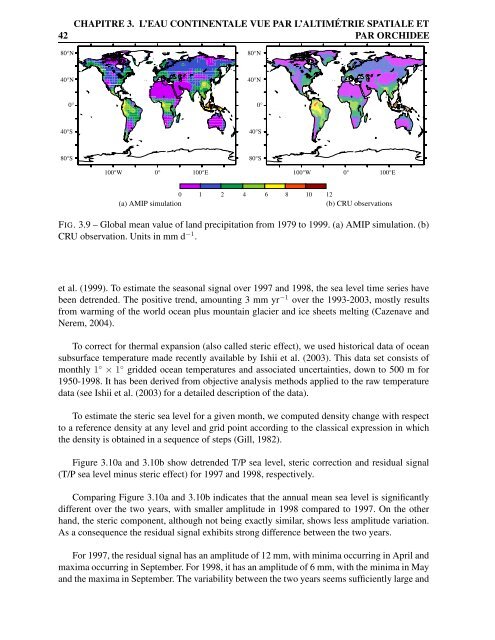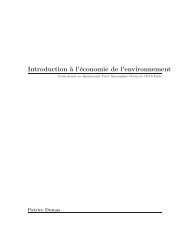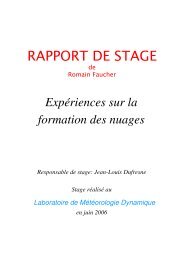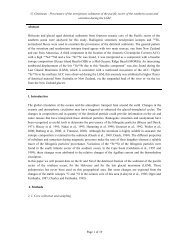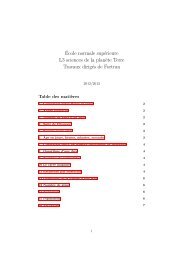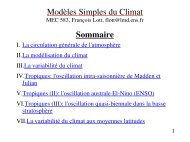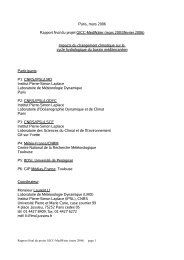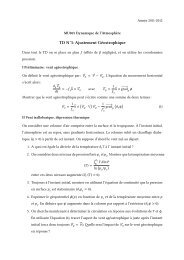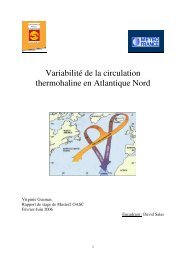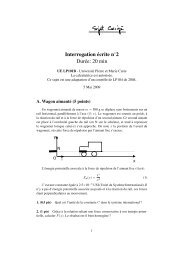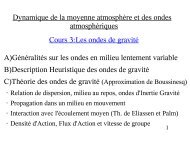variabilité interannuelle et tendances. Comparaison aux ... - LMD
variabilité interannuelle et tendances. Comparaison aux ... - LMD
variabilité interannuelle et tendances. Comparaison aux ... - LMD
You also want an ePaper? Increase the reach of your titles
YUMPU automatically turns print PDFs into web optimized ePapers that Google loves.
42<br />
CHAPITRE 3. L’EAU CONTINENTALE VUE PAR L’ALTIMÉTRIE SPATIALE ET<br />
PAR ORCHIDEE<br />
80°N<br />
80°N<br />
40°N<br />
40°N<br />
0°<br />
0°<br />
40°S<br />
40°S<br />
80°S<br />
80°S<br />
100°W<br />
0° 100°E<br />
100°W 0° 100°E<br />
0 1<br />
(a) AMIP simulation<br />
2 4 6 8 10 12<br />
(b) CRU observations<br />
FIG. 3.9 – Global mean value of land precipitation from 1979 to 1999. (a) AMIP simulation. (b)<br />
CRU observation. Units in mm d −1 .<br />
<strong>et</strong> al. (1999). To estimate the seasonal signal over 1997 and 1998, the sea level time series have<br />
been d<strong>et</strong>rended. The positive trend, amounting 3 mm yr −1 over the 1993-2003, mostly results<br />
from warming of the world ocean plus mountain glacier and ice she<strong>et</strong>s melting (Cazenave and<br />
Nerem, 2004).<br />
To correct for thermal expansion (also called steric effect), we used historical data of ocean<br />
subsurface temperature made recently available by Ishii <strong>et</strong> al. (2003). This data s<strong>et</strong> consists of<br />
monthly 1 ◦ × 1 ◦ gridded ocean temperatures and associated uncertainties, down to 500 m for<br />
1950-1998. It has been derived from objective analysis m<strong>et</strong>hods applied to the raw temperature<br />
data (see Ishii <strong>et</strong> al. (2003) for a d<strong>et</strong>ailed description of the data).<br />
To estimate the steric sea level for a given month, we computed density change with respect<br />
to a reference density at any level and grid point according to the classical expression in which<br />
the density is obtained in a sequence of steps (Gill, 1982).<br />
Figure 3.10a and 3.10b show d<strong>et</strong>rended T/P sea level, steric correction and residual signal<br />
(T/P sea level minus steric effect) for 1997 and 1998, respectively.<br />
Comparing Figure 3.10a and 3.10b indicates that the annual mean sea level is significantly<br />
different over the two years, with smaller amplitude in 1998 compared to 1997. On the other<br />
hand, the steric component, although not being exactly similar, shows less amplitude variation.<br />
As a consequence the residual signal exhibits strong difference b<strong>et</strong>ween the two years.<br />
For 1997, the residual signal has an amplitude of 12 mm, with minima occurring in April and<br />
maxima occurring in September. For 1998, it has an amplitude of 6 mm, with the minima in May<br />
and the maxima in September. The variability b<strong>et</strong>ween the two years seems sufficiently large and


